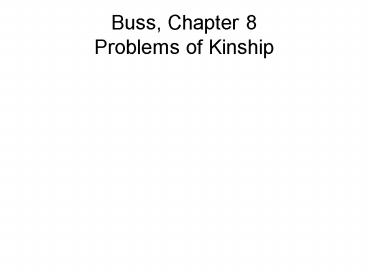Buss, Chapter 8 Problems of Kinship - PowerPoint PPT Presentation
1 / 16
Title:
Buss, Chapter 8 Problems of Kinship
Description:
Under what conditions will an 'altruistic gene' spread in a population? ... genealogy. Females more knowledgeable about extended family can name more relatives ... – PowerPoint PPT presentation
Number of Views:87
Avg rating:3.0/5.0
Title: Buss, Chapter 8 Problems of Kinship
1
Buss, Chapter 8Problems of Kinship
2
Hamiltons Rule
- Under what conditions will an altruistic gene
spread in a population? - c product of the benefit to the recipient X the
degree of relatedness between actor and recipient
3
Hamiltons Rule
- Examples for siblings or parents/children,
benefit must at least double cost, as they are
approximately .5 related for grandparents/grandch
ildren, benefit must be 4X cost, as relatedness
is about .25
4
Hamiltons rule
- What does this rule NOT imply? That an
individuals decision will be based just on this
math!! - Theory is that the formula determines when
altruism can be expected to evolve - However, patterns of helping CAN be predicted
based on degree of relatedness
5
Hamiltons rule
- Degrees of relatedness
- Siblings .5 half-siblings .25
- Parents/children .5
- Grandparents/grandchildren .25
- Cousins .125
6
Altruism
- Ground squirrel studies alarm calls
- Predators kill more of those squirrels that give
alarm calls compared to squirrels that do not - Thus, giving alarm call is altruistic
- When do squirrels give alarm calls most reliably?
7
Altruism
- Length of relationship did NOT predict
probability of giving alarm thus, not reciprocal
altruism - Females give more alarm calls than males they
are more likely to be surrounded by relatives
than males are - Even females who do not have offspring nearby
still give alarm calls because of other
relatives support for inclusive fitness
hypothesis
8
Altruism/helping
- Helping patterns in humans
- Number of helping instances correlates with
degree of relationship (in study of women in LA) - Type of helping relatively trivial vs.
substantial - Two main findings degree of relatedness
predicted helping age of recipient also mattered
9
Altruism/helping
- Age helping decreased, in general, with
increasing age (thus decreasing reproductive
value) of recipient, but only for substantial
helping situations for more trivial helping,
actually went up for old recipients
10
Inheritance
- Inheritance and relatedness tend to leave more
to close kin - Leave more to offspring than to siblings, due to
their greater reproductive value - Male-female differences in wills men more
likely to leave all to wives with no strings
attached women often attach qualifications
11
Inheritance
- Logic of sex differences likelihood of
remarrying less for woman, so she is more likely
to give mans assets to their children - Man is more likely to remarry, and then give
assets to new wife her children, so woman may
be less inclined to leave him everything (and
more likely to direct it to children instead of
spouse)
12
Inheritance
- Further support German studymen more likely to
leave assets to wife if she was postreproductive
than if younger (was a hypothetical questionnaire
study) older wife less likely to remarry
divert his assets to his nonrelatives
13
Grandparents
- Paternity certainty joint probabilities
- Least certainty malesongrandchild (FaFa)
- Most certainty motherdaughter--grandchild
(MoMo) - Intermediate certainty mothersongrandchild
(MoFa) - Intermediate certainty fatherdaughtergrandchil
d (FaMo)
14
Grandparents
- Support for hypothesis dep. variablescloseness,
time, knowledge, resources correlated with
paternity certainty pattern - Also, scores were higher for mothers father than
for fathers mothermaybe because infidelity more
common in younger generation than was case in
grandparents generation
15
Aunts uncles
- Similar pattern as for grandparents investing
usually higher through maternal line (e.g.,
siblings of mother) than through paternal line
(siblings of father) - Also found that aunts invest more than uncles, in
general may be because uncles invest more
resources in mating opportunities instead of
descendents
16
genealogy
- Females more knowledgeable about extended
familycan name more relatives - May be because family role was more central to
womens success than for men































